TRADITIONS IN TRANSITION
THE SPIRIT OF SEASON 5
June 23, 2016 | by Richard Scheinin
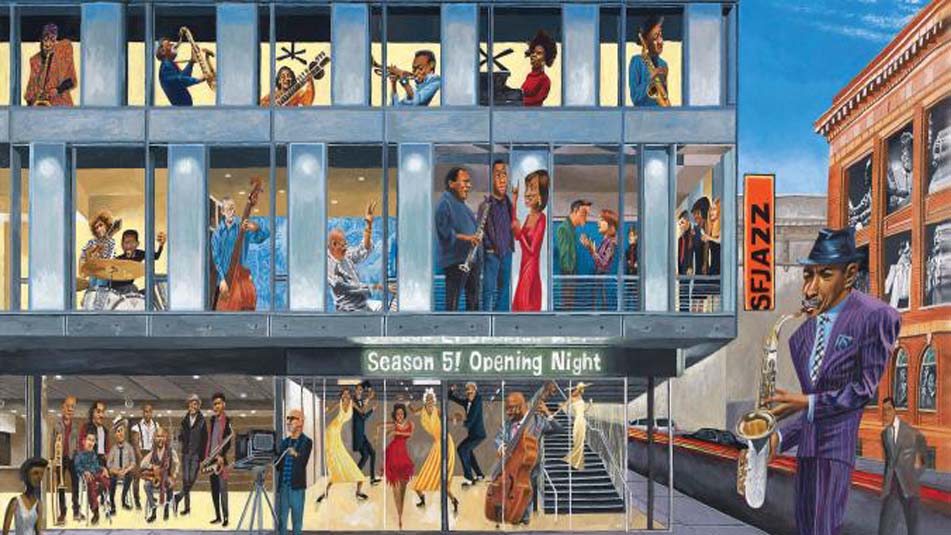
Painting by Mark Ulriksen
"The whole enterprise is a tribute to Ornette and all the other musicians who laid a foundation so that the art can keep moving forward. That’s why we’ve titled the fifth season Traditions In Transition."
– SFJAZZ Executive Artistic Director Randall Kline
The painting on the cover of this brochure tells a story about music and creativity, about inspiration and dreams and the shape of jazz to come. Of course, taken literally, it simply depicts a now familiar streetscape: the SFJAZZ Center at the corner of Franklin and Fell streets. The marquee announces that the hall’s fifth season is about to begin, as it will on Sept. 8.
But then our eyes start to roam across the painting, and its hidden stories and symbols emerge. Artist Mark Ulriksen – a San Franciscan whose work has graced numerous covers of the New Yorker magazine – has populated his painting with the likenesses of 25 musicians, each with a connection to SFJAZZ and its audiences. Most notably, over in the lower right-hand corner, the late Ornette Coleman stands in purple-pinstriped splendor, alto saxophone in hand, blowing the blues and looking a little mischievous, a trace of a smile crossing his face. It’s as if Ornette is still around, the pied piper of SFJAZZ, his spirit having taken up residence at the corner of Franklin and Fell to pose a question and a challenge: “What’s next? Surprise me.”
Randall Kline, who founded and directs SFJAZZ, likes to talk about gambles and grand experiments – including the risks that went into building the $64 million complex and concert hall. In an ageofmusic streaming and Spotify, would audiences come, night after night, to hear live music at the SFJAZZ Center? As the hall moves into its fifth season, is the grand experiment working? It is. The dream is on track, and Kline sees the whole enterprise as a tribute “to Ornette and all the other musicians who laid a foundation so that the art can keep moving forward. That’s why we’ve titled the fifth season `Traditions in Transition,’ because this music is constantly in transition. It’s constantly pushing boundaries so that the shape of jazz to come” – the title, by the way, of Coleman’s most famous album – “is always an unknown. You can’t predict where it’s headed.”
The painting offers some clues.
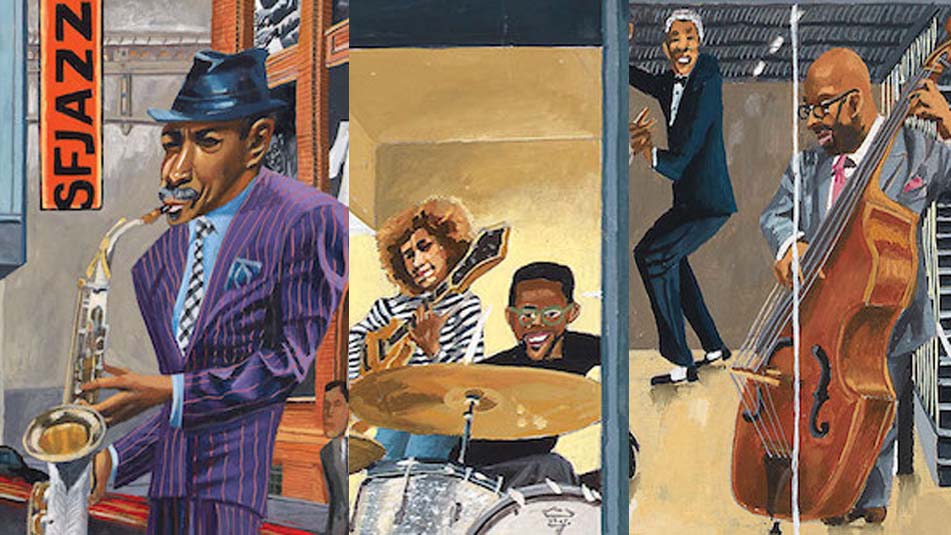
The 2016-17 season (the 34th overall for the organization) opens Sept. 8-11 with Pat Metheny, who can make his guitar sound like a cosmic air raid siren. (In the painting, Metheny is the wild-haired guy in the far-left window on the second floor.) Later in the month (Sept. 22-25), bassist Christian McBride, one of four resident artistic directors, brings in four different bands, one for each night. (Ulriksen places McBride in the lobby, laying down a groove for the decked-out dancers.) Another great bassist stands on the floor above: Dave Holland (second window from the left), alone with his instrument, perhaps getting ready for the solo recital he will perform as part of his upcoming residency (March 30-April 2). His last solo show for SFJAZZ was in 2013, during the hall’s first season, and if you were there you will remember the way his warm and sturdy sound filled the room. The night’s intimacy was one of the first signs that the new hall works, bringing performers and audience so close to one another (no seat is more than 55 feet from the stage) that a special energy happens. Holland said he felt as if he were performing for family in his living room.
The glass-lined building was designed – you can see it in the painting – to merge with the street. You can look straight into it. It extends an invitation to whoever passes by, regardless of whether they know anything about jazz. “There’s an openness,” Kline says, explaining that “this whole organization’s built on the idea that if you just get a little more experience with this music, get a little more exposure, you might enter this world. It is a world, and that’s one of the things the painting is showing – how the building radiates this history.”
Okay, now we’re into the painting’s historical dimension, so take your eyes up to the top floor and its pantheon of departed souls. In the third window from the right, Miles Davis strikes a classic pose, leaning back with his trumpet. Davis never performed for SFJAZZ, yet his shadow is all over the fifth season via his former band members: bassist Holland; pianist Chick Corea (not in the painting), who performs Sept. 29-Oct. 2 with a special trio; and Wayne Shorter (second floor, third window from the right, holding his soprano saxophone) who returns April 27-30 with his own quartet. Standing next to Shorter is one of Davis’s younger, genre-defying descendants: keyboardist Robert Glasper, who scored Don Cheadle’s recent Davis biopic “Miles Ahead” and performs Dec. 8-11. Finally, on the ground floor, staring at us through the window, is the SFJAZZ Collective, the eight-piece all-star group that will play its new arrangements of Davis tunes, Oct. 20-23, sending Miles in new directions 25 years after his passing.

Now look to the far-right window of the top floor: There’s Lester Young, hugging his tenor saxophone. Master of ballads and blues, of floating swing and shapely sound, he was a muse to Miles – and his name graces the Lester Young Green Room where performers relax backstage. Chucho Valdes knows that room; he has performed nearly every year at the SFJAZZ Center and returns Nov. 17-20 to co-lead a quintet with saxophonist Joe Lovano. (In the painting, that’s Valdes appearing ecstatic at the keyboard on the second floor, third window from the left.) Also right at home is vocalist Mary Stallings, who was born just a few blocks away in 1939, sang in the early ‘60s with Dizzy Gillespie at the Black Hawk nightclub at the corner of Turk and Hyde, and now returns to SFJAZZ as a resident artistic director with her own week of shows, May 4-7. She stands in the window directly to the right of Valdes, joined in imaginary conversation with Shorter and Glasper.
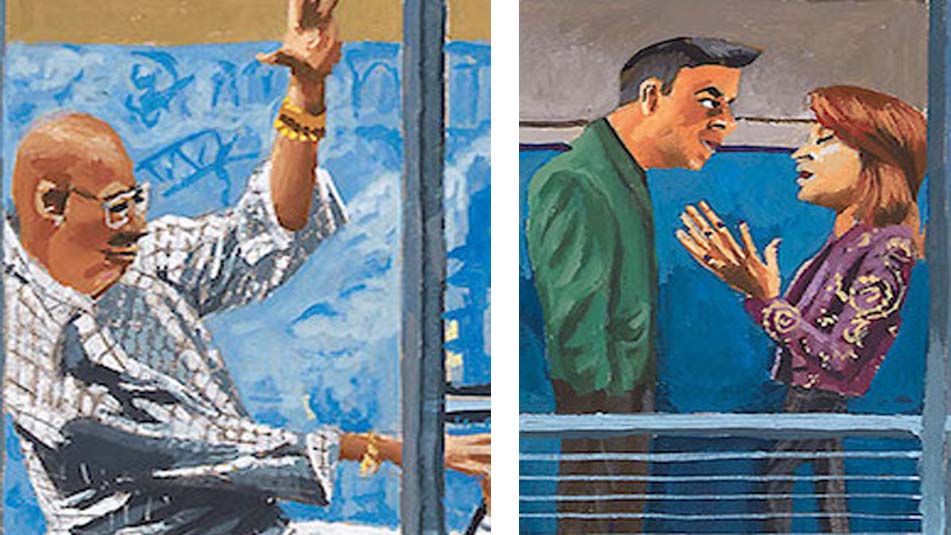
In the window to her right, pianist-composer Vijay Iyer and singer-songwriter Rosanne Cash are locked in yet another imaginary dialogue, while several members of the SFJAZZ High School All-Stars stand shyly to the side. Maybe they’re listening in as Iyer and Cash – both resident artistic directors in Season 5 – compare notes about life in Manhattan. Iyer recently finished a performance residency at the Met Breuer, part of the Metropolitan Museum of Art. Cash has been unofficial musician in residence at the Rubin Museum of Art, where Elvis Costello once joined her for a program built around the concept of magic numbers. And what have Iyer and Cash devised for their SFJAZZ residencies? Iyer (Feb. 9-12) is calling upon vanguard trumpeter Wadada Leo Smith and writer Teju Cole, among others, while Cash shares her week (May 18-21) with Lucinda Williams and Emmy Lou Harris.
Onward.
Again on the top floor, look all the way to the left: There’s the late saxophonist Dewey Redman, master of avant-blues and earthy bebop. He performed for years with Ornette Coleman – they played like brothers, their concepts so compatible -- and later participated in a Coleman-inspired quartet called Old and New Dreams. (Its other members were Don Cherry, Charlie Haden and Ed Blackwell.) That band is now the inspiration for the Still Dreaming quartet assembled by Dewey’s son, saxophonist Joshua Redman. With Brian Blade on drums – in the painting, he shares the window with Metheny -- it performs March 23-26 and allows Joshua to spin his father’s tradition through new transitions. Incidentally, it was Joshua Redman who coined the phrase “Traditions in Transition” – that was back in 2000, when, at age 31, he curated SFJAZZ’s first spring season and gave it that title.
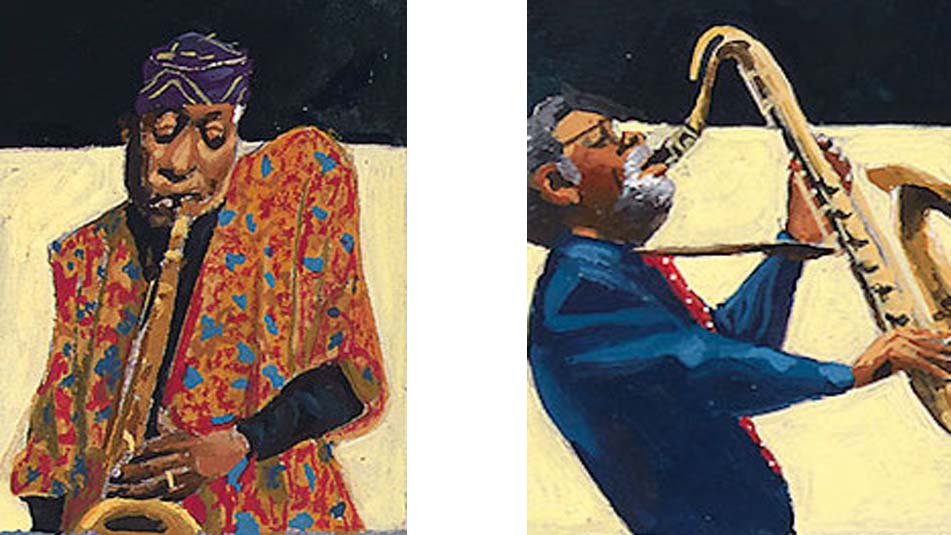
Back to the painting: To the immediate right of Dewey Redman is saxophonist Joe Henderson, who lived his last 30 years in San Francisco and helped put SFJAZZ on the map. The center’s 100-seat Joe Henderson Lab – part night-club, part rehearsal space—doesn’t just carry his name: “Joe’s energy is in that room,” says Kline, “the spirit of Joe, who was so open and willing to take chances.”
Three windows to the right of Henderson is pianist Alice Coltrane, who, in November 2006, performed her final concert. It was presented by SFJAZZ at the Nob Hill Masonic Center and it was one of those nights. Alice’s son, saxophonist Ravi Coltrane – named after Ravi Shankar (top floor, directly to the left of Miles Davis) -- went to the well for an extended solo on “Impressions,” composed by his father, John Coltrane. As he blew big, spiraling gusts of notes, bluesy and free, his mother watched him with a delighted "Oh my'' smile. When the saxophonist finished, drummer Roy Haynes simply stopped playing, stood up and shook his hand. The audience exploded in shouts.
“One of those transcendent moments, right?” asks Kline, who lives for such moments.
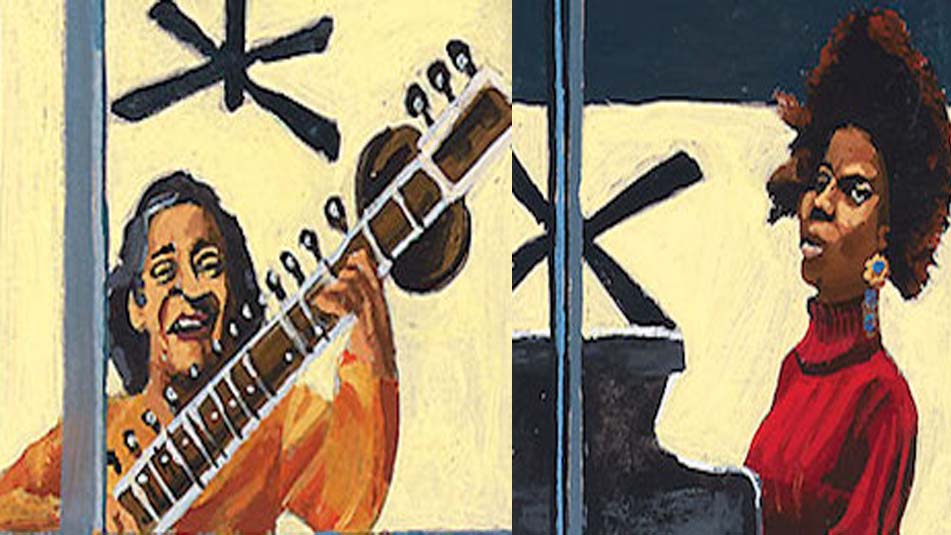
Entering the fifth season at the SFJAZZ Center, he’s still trying to figure out how to stack the deck to make them happen. “How do you create this situation where the performers feel comfortable and the audience feels comfortable, so there’s this energy thing that happens?”
He ticks off a few of the design features of the hall that help: “Great sound system, great backstage facilities. And we have this very bourgeois idea of giving you a cup holder next to your seat for your cup of wine.” He laughs at the bougie-ness of it. “But that’s a nice thing. Who doesn’t like that?”
In the end, though, it’s not about the cup holder.
“We’re not looking for perfection. We’re looking for vibe. The idea is that we’re pushing forward and there’s more to be done. The spirit of Ornette and Joe and all these people – that spirit is here. That’s what emanates from this building, that there’s something in here that’s potentially going to uplift you and change you.”
– SFJAZZ Executive Artistic Director Randall Kline
